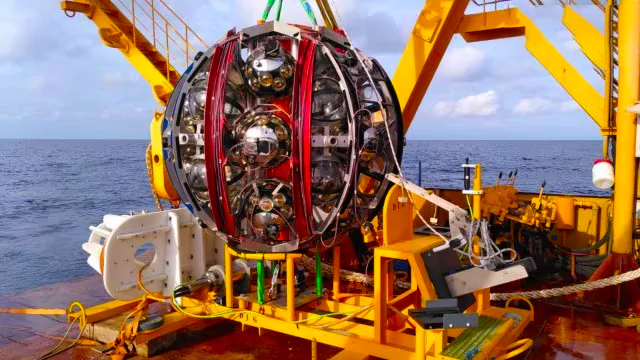Scientists are deploying two telescopes under the Mediterranean Sea to detect high-energy neutrinos, also called ghost particles.
What Are Neutrinos?
- Neutrinos are tiny particles similar to electrons but have no electric charge.
 They are one of the fundamental building blocks of the universe.
They are one of the fundamental building blocks of the universe.- Neutrinos were detected for the first time in 1959.
- Neutrinos are the second most abundant subatomic particles in the universe, after photons.
- They are incredibly numerous, with about 1 billion neutrinos passing through a single cubic centimetre of space every second.
- They are known as “ghost particles” because they barely interact with anything.
- Sources of Neutrinos
- Neutrinos are produced when heavy particles transform into lighter ones, a process called “decay.”
Enroll now for UPSC Online Course
Indian Neutrino Observatory (INO)
- It is a project to build a world class underground lab to study fundamental scientific concepts.
- Objective: Its main study is focused on the study of neutrinos.
- Funded by: Department of Atomic Energy and the Department of Science and Technology.
|
-
- These neutrinos originate from distant and exotic cosmic events like:
- Supernovae
- Gamma-ray bursts
- Colliding stars
- While neutrinos are abundant, scientists focus on rare, high-energy neutrinos traveling at incredible speeds.
Importance of Studying High-Energy Neutrinos
- Exploring Hidden Regions of Space
- High-energy neutrinos can penetrate dusty regions in space, such as the centre of the Milky Way.
- Unlike visible light, which is absorbed or scattered by dust, neutrinos pass through, revealing hidden cosmic mechanisms.
- Understanding Cosmic Rays and Dark Matter
- They provide clues about how cosmic rays are produced.
- They may also shed light on dark matter, one of the universe’s greatest mysteries.
- Unlocking New Discoveries
- Studying neutrinos could lead to the discovery of unknown phenomena that scientists cannot yet imagine.
Challenges in Detecting Neutrinos
- Rare Interaction with Matter
- Neutrinos barely interact with other particles, making them extremely hard to detect.
- Despite billions of neutrinos passing through us every second, only one might interact with a human body in an entire lifetime.
- High-Energy Neutrinos Are Rare
- High-energy neutrinos are uncommon and originate from rare cosmic events like supernovae and gamma-ray bursts.
- Even advanced observatories like IceCube, operational since 2011, have detected only a limited number of these particles.
- Need for Large Detection Volumes
- Neutrino detection requires a huge volume of transparent material, such as ice or water, to observe the faint flashes of light they produce.
- Requirement for a Dark Environment
- Detection relies on observing Cherenkov radiation, faint light flashes produced when neutrinos interact with water or ice molecules.
- A dark environment is crucial to minimize interference from other light sources.
- Light Absorption and Scattering
- Materials like ice and water affect light differently:
- Ice scatters light more, making it harder to trace the exact source of neutrinos.
- Water absorbs light more, reducing the amount available for analysis.
Check Out UPSC CSE Books From PW Store
About the Telescopes
- These telescopes are part of the Cubic Kilometre Neutrino Telescope (KM3NeT) project.
- Purpose of the Telescopes
- Studying Space Neutrinos: One telescope will detect high-energy neutrinos originating from outer space.
- Analyzing Atmospheric Neutrinos: The other will focus on neutrinos generated in Earth’s atmosphere.
- The KM3NeT telescopes are similar to the IceCube Neutrino Observatory in Antarctica, which also studies high-energy neutrinos.
- Difference:
- IceCube is embedded in the frozen ice, while KM3NeT telescopes are placed underwater in the Mediterranean Sea.
Key Benefits of Underwater Telescopes
- Clearer Detection: Water scatters light less, improving neutrino tracking.
- Cosmic Exploration: Studies hidden phenomena like supernovae and gamma-ray bursts.
- Large Volume: Deep-sea water enables effective neutrino detection.
- Better than Ice: Water-based telescopes offer clearer conditions than ice ones.
|
![]() 3 Jan 2025
3 Jan 2025

 They are one of the fundamental building blocks of the universe.
They are one of the fundamental building blocks of the universe.